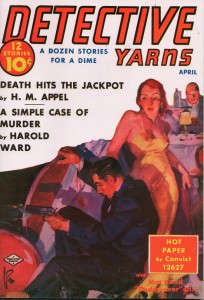Magazine Review: Detective Yarns April 1939
This is a facsimile reprint by Adventure House of a pulp magazine. Pulp magazines tended to stick to one genre, so you knew what you were getting from the beginning; in this case action-mystery. Great literature was rare, but they really got the blood pumping. And a dozen stories for a dime was good value for money.
 “The Devil Deals to G-Men” by Wyatt Blassingame takes us to the bayou country of Louisiana, with an FBI agent going undercover as a nature painter to investigate the disappearance of a game warden and death of a fellow G-man. An oppressive atmosphere and suspicious locals make our hero’s job a lot harder. Uses the cliche of the only woman on the island being somehow nicer than everyone else.
“The Devil Deals to G-Men” by Wyatt Blassingame takes us to the bayou country of Louisiana, with an FBI agent going undercover as a nature painter to investigate the disappearance of a game warden and death of a fellow G-man. An oppressive atmosphere and suspicious locals make our hero’s job a lot harder. Uses the cliche of the only woman on the island being somehow nicer than everyone else.
“Pin Game” by Wilbur S. Peacock has an Italian restaurant owner threatened by an insurance racket. A rare case of a pinball game (at the time, these were gambling devices) used for good. This story uses ethnic slurs.
“Death Hits the Jackpot” by H.M. Appel continues the gambling theme. A small town has “nationalized” the local slot machine racket, much to the anger of the crook who was running it before. But is he the one who rigged one of the machines to explode when it hit the jackpot? Or is it the crazy street preacher? The man whose son committed suicide over gambling losses? Or a person you’d never suspect? Something to consider when you visit your state-run casino.
“Double for Death” by Thad Kowalski concerns a red-headed tramp who sticks his nose in when he sees a damsel in distress. But why does everyone seem to recognize him? Very predictable twist.
“A Simple Case of Murder” by Harold Ward has a woman plotting to kill her husband; to be honest, forensics would have spotted the hole in her plan, even if she didn’t make a fatal mistake….
“Hot Paper” by Convict 12627 is a fact-based piece about fraudulent check-passing. Of note is that the crooks take the anti-fraud measures previously introduced and use them to make the plan easier. (Wouldn’t work nowadays because the outlay to set up the scam would be more than you could possibly earn before getting caught–credit cards are where the lucrative fraud is.)
“God’s Burning Fingers” by Joseph L. Chadwick has a great title. Meteorologist Michael Vane, also known as “the Weather Detective” is involved with a case where a man has apparently been burned to death by Saint Elmo’s Fire. This immediately rouses his suspicions. The case is complicated by faulty eyewitness testimony and anti-Japanese racism.
“Bloodstains on White Lace” by “Undercover” Dix is another fact-based story, about the kidnapping, rape and murder or human trafficking of Irish lace-makers in Chicago around the turn of the Twentieth Century. There’s some vivid imagery, but also brutal details of what had been done to a survivor (eliding the actual rape.) At the time this piece was written, human trafficking was often called “white slavery” as though slavery was especially heinous when done to white people. The writer also makes a point of specifying how pretty the kidnapped girls were.
“I’ve Got a City Full of Sin” by Louis Trimble features a detective whose sister has gone missing, and gets himself convicted of drunk driving (apparently a felony in California at the time) to infiltrate a criminal gang. Our hero’s female sidekick is surprisingly competent and independent for the time period and genre.
“Suicide or Murder” by William Degenhard has a postal inspector investigating the supposed suicide of a man who’d just called him over to discuss something. The explanation uses some dubious science.
“Never Kill a Copper!” by Paul Selonke is about a police officer being framed for the murder of a gangster, and his private eye friend looking into it. Double crosses abound. Of note, when this was written, two unrelated men could be roommates in an apartment and no one would think anything was odd.
“Ashes of Gold” by Mat Rand takes a sharp veer into noir territory. The crime being investigated is an auto theft ring, But the real plotline is about our protagonist’s best friend marrying a gorgeous ash-blonde woman and then inviting the protagonist to live with them in their small apartment. The situation soon turns explosive. It’s possibly the best story in the issue, but there’s a whopping dose of misogyny here that will not sit well with some readers.
As a facsimile, this reprint comes complete with the original ads, including a book on “married love” and a product for “Perio Relief Compound” which allegedly cured period delay in women.
Recommended for fans of pulp crime stories.

I think they also used the term White Slavery trying to say what had been done without mentioning sex in polite society.
That makes sense. Thanks, Mom!